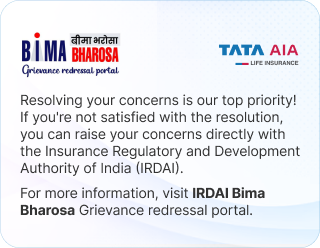28-07-2022 |
Life insurance plans are financial instruments that help secure your family in the event of your unexpected death. Insurers have introduced different life insurance plans to extend benefits based on individual requirements. A whole life insurance policy is one such plan that provides the necessary financial benefits to your nominee in the event of your death at any time. There are different types of whole life policy.
Before getting into the details, let us understand what a whole life insurance plan is, the types of whole life insurance, and how it differs from other life insurance plans.
What is a Whole Life Insurance Plan?
Whole life insurance plans offer lifelong coverage, generally up to 99 or 100 years. In contrast to term insurance, which is limited to a fixed tenure, this plan remains in effect throughout the life with regular premium payments. The beneficiaries receive a guaranteed death benefit and meanwhile the plan gradually builds a cash value over time. You can obtain the accumulated funds through loans or partial withdrawals. A whole life insurance plan suits individuals who want lifelong security as well as capital growth.
Generally, the maturity age for a whole life plan is 100 years. However, it depends on the insurer's terms and conditions.
Types of Whole Life Insurance Plans

Whole life insurance comes in various forms, each designed to meet different financial needs and payment preferences. The types differ in premium payment structures, cash value growth, and coverage features. Understanding each type helps you choose the right plan that aligns with your financial goals and budget. The following are the various types of whole life policies:
- Non-participating whole life insurance plans
- Participating whole life insurance plans
- Level premium whole life insurance
- Limited premium whole life insurance
- Single-premium whole life insurance
- Variable whole life insurance
- Modified whole life insurance
Non-participating whole life insurance plans
This type of life insurance plan provides life coverage to the policyholder that ascertains the sum assured to the nominee in the event of their unexpected demise.
Apart from the life cover, the policyholders will not receive any share of the profits earned by the insurance provider as a bonus1 or dividend in a non-participating whole life insurance plan. It is cost-effective compared to the participating whole life insurance plans.
Participating whole life insurance plans
Participating whole life insurance is a life insurance plan that provides additional financial benefits in the form of bonuses1 or dividends apart from regular life coverage. Like any other organisation, a life insurance company also makes profits every financial year. The insurers will provide these profits to the policyholders who have purchased the participating whole life insurance plans.
The profits earned are provided to the policyholders on a predominantly annual basis. However, the payouts differ based on the performance of the company. The bonuses1 earned out of a participating whole life insurance policy can be used to offset premiums that have to be paid later, to accumulate and earn interest, receive them as cash payouts, etc.
Level premium whole life insurance
A level premium whole life insurance is a variable whole life insurance plan wherein the premium rate remains constant and is not subject to increase for any reason. When the policyholder pays the premium regularly throughout the policy tenure, the sum assured is paid to the nominee in the event of their unexpected death.
Limited premium whole life insurance
In a limited payment life insurance policy, the policyholder will have to pay the premium for a limited term. However, the life coverage is for the whole life or until 100 years. The premium is paid for a limited number of years. Considering the benefit of paying the premium for a limited period, it is available at a slightly higher rate. It is beneficial for people planning to pay the premium until retirement while ascertaining the life cover benefit until death.
Single-premium whole life insurance
In a single premium whole life insurance, you pay a lump sum in advance instead of monthly or yearly premiums. Once paid, the policy and cash value remain funded for your entire life with a guaranteed death benefit. You start with an immediate cash value that can grow at a fixed interest rate over time.
Variable whole life insurance
This policy offers lifelong coverage with a cash value component tied to the investment options you choose. The cash value isn't guaranteed and varies based on your investment performance. If the market performs well, your cash value grows significantly; if investments perform poorly, your cash value can decrease and may impact your death benefit.
Modified whole life insurance
You pay lower premiums during the first few years, which then increase after the introductory period and remain higher for life. The lower premiums typically last two to three years. Your premiums won't contribute to the cash value account until the introductory period ends, which can impact savings growth over time.
How to choose the right whole life insurance
The suitable type of life insurance plans depends on your financial requirements and conditions. If your primary aim is to secure your family’s future, a non-participating whole life plan is suitable. However, if you want a share in the insurer’s profits, a participating whole life plan is better. For those seeking consistent premiums and lifelong cover, a level premium plan works well. Meanwhile, salaried individuals who prefer paying premiums only until retirement can opt for a limited premium plan.
Insurers provide varied products with flexible features based on individual needs. For example, Tata AIA Life Insurance allows increasing the sum assured at different life stages and receiving payouts as a regular income, a combination of lump sum and regular income, or only as a lump sum.
Conclusion
Whole life insurance plans offer coverage for the insured’s entire lifetime, guaranteeing a death benefit without being limited to a fixed policy term. Unlike term insurance, these plans remain valid throughout life as long as premiums are paid. They are available in multiple variants—participating, non-participating, level premium, limited premium, and single premium. The ideal plan should be chosen based on one’s financial objectives, affordability, and long-term protection goals to ensure lasting financial stability for the family.











 FOR EXISTING POLICY
FOR EXISTING POLICY 
 FOR NEW POLICY
FOR NEW POLICY 








